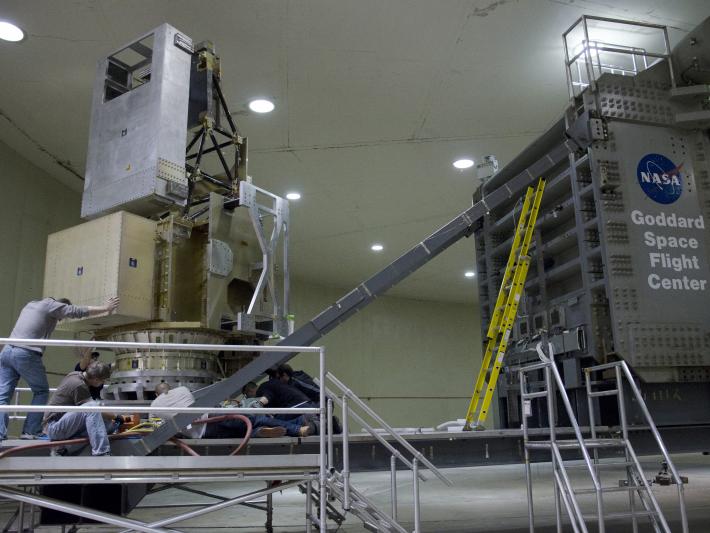
GPM Takes a Spin on the Centrifuge
In the clean room at NASA Goddard Space Flight Center in Greenbelt Md., the Global Precipitation Measurement (GPM) mission's Core satellite is steadily taking shape. Set to measure rainfall worldwide after launch in 2014, GPM's two solar panels are the latest components currently undergoing rigorous testing before being integrated with the spacecraft, a process that began seven months ago when the main structural elements went on an unusual ride.
Video Credit: Brooke Harris
Ambient audio only.
Although it was still dark outside on the morning of March 28, 2011, Building 15's test facility was already abuzz with activity. "You want it at 8 a.m., we'll start at six," said engineer Bill Chambers. He’s been running the High Capacity Centrifuge at Goddard for the past 22 years.
Chambers was standing in a massive circular room that looks a little like the inside of a circus tent. But this circus has only one attraction: the High Capacity Centrifuge. It’s a steel bridge-like structure attached to the center of the floor on a giant rotating bearing. Now, as part of the two-hour checklist the technicians follow to get the centrifuge up and spinning, lubricant oil was pumping through that giant bearing because this massive, 600,000 pound piece of machinery would ultimately spin up to 15 rotations per minute.
The centrifuge spans the entire width of the room like outstretched arms. At the end of one arm is a bulbous chamber. At the other, a platform where the heaviest structure ever to be tested would soon sit: GPM's 8,000-pound Core satellite.
The GPM mission was initiated by NASA and the Japanese Aerospace Exploration Agency and has many international partners. It will provide rainfall data worldwide, including information on tropical cyclones and hurricanes. The successor to the Tropical Rainfall Measuring Mission (TRMM), the GPM mission expands on TRMM's coverage by using a constellation of existing partner satellites that take similar measurements and unifying them into one global data set every three hours.
Built at NASA Goddard, the Core satellite has three major structural sections: propulsion, the lower bus, and the upper bus. The bus is the infrastructure of a spacecraft, usually providing locations for instruments. Together, they make up the body of the spacecraft and each part will undergo three to six times the force of normal gravity when it launches into space. During this March test, the centrifuge would test their mettle.
Buckle Up

Credit: NASA/Goddard/Rebecca Roth
Just inside the 30-foot doors to the centrifuge, a crane in the ceiling lifted the spacecraft onto the platform. The upper bus and qualifying duplicates of the lower bus and propulsion sections were attached to mock-ups of the other parts of the satellite, including the instruments, to simulate all the weight the spacecraft's body has to bear. Once in place, the team bolted the satellite into a fixture that’s specially designed to hold it on the centrifuge. Then they connected a bundle of wires that ran from the 120 sensors on the satellite to the centrifuge computer.
Meanwhile, the centrifuge bearing had been lubed up and every moving part of the centrifuge had been checked out. With the satellite secured, the room cleared for the balance run.
The first step was a phone call. Bill Chambers needed to tell Goddard's power substation that the centrifuge would cause a power spike equal to turning on 16.6 million 60-watt incandescent light bulbs at once. "For less than a nano-second, we're going to ask for one gigawatt -- one billion watts of energy," said Chambers. That’s needed just to turn on the system because, as Chambers said, "600,000 pounds is sitting there going "I don't want to move.""
The centrifuge slowly began to revolve at a lazy three rotations per minute. As it moved, a sensor located near the central bearing measured how much each of the two arms bend under the weight they’re carrying. Like an unbalanced washing machine, an unbalanced centrifuge will wobble and throw off its load. And that’s dangerous because it could destroy not only the satellite but also the centrifuge itself and maybe even Building 15.
Once the right amount of weight was added or subtracted to get everything balanced, the centrifuge techs closed the room’s 30-foot tall doors. Then, the entire hallway outside the centrifuge was cleared out because, if something went wrong, metal could blow right through them.
The GPM engineers and the centrifuge team retreated to the safety of the control room and gathered around two live feeds -- one was video of the satellite on the platform and the other was live data streaming wirelessly from the centrifuge computer.
Ready to go, they made one more call down to the power substation, and the centrifuge spun to life.
Article By: Ellen Gray
Originally Posted on www.nasa.gov
NASA's Goddard Space Flight Center, Greenbelt, Md.

